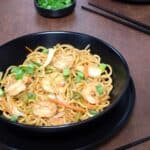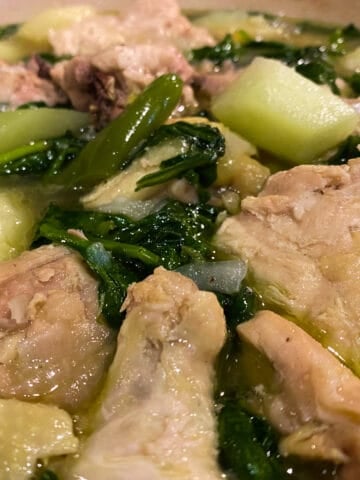Often described as the ultimate comfort food for colder days, Sinigang is a savory soup that carries a profound sour taste that resonates deeply within Filipino cuisine. Gaining traction not just in the Philippines but also in the United States and other parts of Asian cuisine, Sinigang stands out for its distinct flavor, variety of vegetables, and versatility in terms of protein used.
Jump to:
What is Sinigang
Sinigang is a Filipino sour soup, primarily defined by its distinct sour taste. This sour flavor, which tantalizes taste buds, is achieved through natural ingredients like tamarind, green mango, or tomatoes. However, for those pressed for time or without access to fresh fruit, premade tamarind paste, tamarind powder, or even a commercial sinigang mix can be used. The soup base, whether from a tamarind soup base or a souring agent like green mango, is complemented by a variety of vegetables such as water spinach, bok choy, string beans, or even Chinese long beans. Adding fish sauce provides a savory depth, while black pepper adds a touch of heat.

The Origins of Sinigang
This favorite Filipino dish traces its roots back to the Philippines' pre-colonial times. Its popularity is an ode to the country's tropical climate, abundant in tangy fruits like tamarind. As time progressed, Sinigang has evolved in different ways, with regions and even families boasting their unique variations of sinigang.
Types of Meat Used in Sinigang
Sinigang’s sour broth serves as a savory canvas for an array of proteins. The choice of meat or seafood can drastically alter the dish's flavor profile, texture, and cooking time.
Pork
- Pork Belly: Tender and fatty pork belly brings a creamy texture to the soup. The marbling melds well with the sour broth, making it a popular choice. My recipe for Pork Sinigang (Pork Belly) showcases this cut beautifully.

- Pork Ribs: These provide a meatier option, with bones contributing a richer, deeper flavor. My recipe for Sinigang uses country pork ribs cooked in an Instant Pot.

- Pork Shoulder and Pork Butt: Lean meat options that need slow cooking to achieve a soft texture. These cuts are great options for those who prefer less fat.
- Variations: The crispy pata sinigang adds an extra frying step to infuse the broth with a different layer of savory flavors. Sinigang na bagnet is a twist using a crispy pork belly, offering an added crunch.
Beef
For beef sinigang, cuts like spare ribs and corned beef are popular. They require extended cooking times, especially in a slow cooker, to break down the collagen and make the meat tender. The result? A hearty, meaty soup rich in flavor. Beef Sinigang is a testament to the dish's adaptability.
Shrimp
A lighter, fresher alternative to red meat. Shrimp adds a delicate seafood flavor. The key is not to overcook them. My recipe for Shrimp Sinigang with Tamarind Filipino Sour Soup uses the sour taste of tamarind soup base, blending perfectly with the shrimp's natural sweetness.

Fish
Different types of fish can be used, each bringing a unique flavor. They offer a lean meat option, making the soup lighter and more delicate. The sinigang broth's sourness complements the fish's natural flavors, making it a favorite choice on many dinner tables.
- Bangus (Milkfish): As the national fish of the Philippines, it's no wonder that bangus is a top choice for Sinigang. Known for its meaty texture and the absence of overpowering fishiness, bangus lends a subtly sweet contrast to the sour broth. Given its relatively thicker skin, the bangus absorbs the flavors of the broth, offering a burst of sourness with every bite.
- Tilapia: Another popular choice for Sinigang, Tilapia is widely available and affordable. It has a mild, almost neutral taste, making it perfect for those who prefer a milder fish flavor in their soup. Its firm flesh ensures that it remains intact even after simmering for some time, giving diners meaty chunks to enjoy.
- Salmon: Often using the head and belly parts, Salmon Sinigang is a delightful variant. The fatty parts of the salmon bring a rich, creamy texture to the soup. Its distinctive taste pairs well with the sour broth, creating a delightful contrast between the fish's natural oils and the tamarind base.
- Pomfret (Pampano): A prized fish in many Asian cuisines, Pomfret makes a delightful addition to Sinigang. Its slightly firmer flesh and mild flavor profile, combined with fewer bones, make it a favorite for many. It's especially appreciated by those who wish to enjoy their soup without the interruption of pesky bones.
- Tuna: A meatier option, Tuna offers thick, firm chunks that hold their shape well in the sour broth. While its flavor is more robust than Tilapia or Bangus, it's not overpowering and complements the sour flavor of the broth beautifully.
Tips for Choosing the Best Sinigang Protein
When sourcing fish for Sinigang, freshness is paramount. It's crucial to choose fish that has clear eyes, firm flesh, and a clean, ocean-like scent.
Asian supermarkets or Filipino markets usually offer a wide range of meat cuts suitable for Sinigang. For those in the United States, these markets are the best way to find authentic ingredients.
For more convenience, especially for a one-pot meal, using gadgets like the Instant Pot can cut down the cooking time significantly. For inspiration, my recipe for Instant Pot Sinigang Pork offers a delicious meal in much less time.
Ingredients That Make Sinigang Unique
Apart from protein, the main ingredients that make Sinigang a delightful Filipino soup include:
- Souring agents: Tamarind is the most popular, but green mango and other natural ingredients can also be used. For ease, tamarind powder or sinigang mixes like mama sitas are available.
- Vegetables: Various vegetables like water spinach, green beans, taro root, and sweet potato are used. Depending on the cooking method, these can be added at different times to ensure they retain their texture.
- Seasoning: Fish sauce, black pepper, and sometimes soy sauce are used for seasoning.
Sinigang's appeal isn't just in its sour taste but in its adaptability. Whether pork, beef, shrimp, or fish, the dish welcomes all with open arms, offering different variations to cater to varied taste buds. It's this versatility that has cemented Sinigang's place as a timeless classic in Filipino and Asian cuisine.
Sinigang Recipes To Try
Looking for sinigang recipes like this? Try these:
Soup Recipes You May Like
Some of my favorite soup recipes you may also like.
























Comments
No Comments